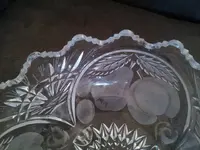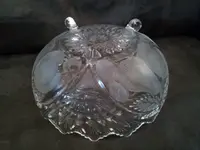
Dylan
If i remember correctly a small metal wheel is used with diamond dust to cut the glass. Its been a while since ive seen it. Think i saw it on a show on TV. If its cut glass then the whole design is cut glass. Some of that stuff is pretty expensive.Especially if its old. I'm far from being an expert on it so i dont really have a clue to what its worth.
This might help
# Check for seams. Glass from a mold often has seams, which show as lines in the finished product. The number of lines depends upon the shape of the finished article & construction of the mould. Depending upon the age of the mold (they wear with use) the pattern may be more or less sharp. In a faceted drop such as a 'crystal', the seam will run all the way around the edge like a ring for poured glass. Although there is nothing to stop pressed glass being cut subsequently the issue is usually: is this design cut or molded?
#
2
Inspect the interior. In poured or pressed glass, the interior of the glass might have have slight dimples that mirror the exterior.
#
3
Examine the design. Hold the glass so that it reflects the light & look, particularly on facets, for fine striations from the tools used on cut glass. These are more obvious on older glass, where polishing was undertaken by hand. However, modern cut glass is chemically smoothed to remove all traces of cutting. This can leave as smooth a finish as good pressed glass. Also, on older cut glass there are often variations in the shape & spacing of the pattern. Not so in pressed glass, where the mould was an expensive item, usually made by craftsmen who perfected the design before it was used.
#
4
If you have a pocket UV light, shine it on the glass. If the tint you see is bluish purple, then the glass is lead glass & more likely to be cut. If it is dull green, then it is soda glass, the cheaper type of glass, & more likely to be moulded. Whether a glass design is cut or pressed is not always easy to tell!
1.
How to Tell if Glass is Cut
* 1
Do the weight test. Cut glass, leaded crystal, is dense. Pick up the glass piece. It should seem extremely heavy. Lift other non-cut glass pieces of the same size for a comparison.
* 2
Do the "ping test" on the glass. Leaded crystal glass is used in cutting due to the softening properties of lead oxide.(Lead oxide allows the glass to be cut without breaking.) Place the glass on a flat surface. With the thumb and forefinger, lightly flick the finger on the glass. If the glass is leaded crystal, a clear ringing sound will be heard. If a dull "thunk" is heard, the glass is not leaded crystal. Move on to the next step, if ringing is heard.
* 3
Hold the piece to the light. Small rainbows should reflect in the sunlight. The light should bounce light from cut to cut.
* 4
Look closely at the cuts. Each cut should have a crisp, clear edge. Pressed or molded glass will have a slightly rounded edge.
* 5
Check for a signature on the bottom of the piece. Cut glass is not always signed, but many manufacturers marked their pieces. American cut glass companies include Libbey, Jewel, Sinclaire, Hoare, Meriden, Hawkes, Tuthill and Dorflinger. Use the link below or purchase a cut glass history book to see the manufacturer's marks that were put on cut glass pieces. Cut glass is also made by design. Take a photo of the piece and compare the design to other identified cut patterns.
Read more: How to Tell if Glass is Cut | eHow.com
http://www.ehow.com/how_4884279_tell-glass-cut.html#ixzz1in5BK200




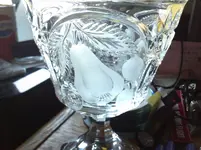
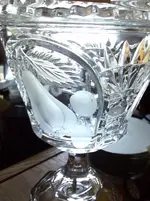
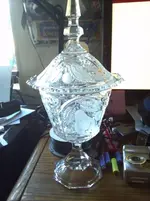
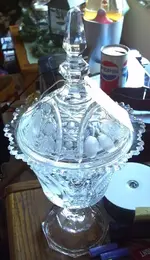
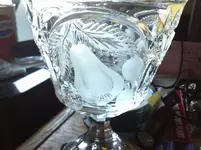
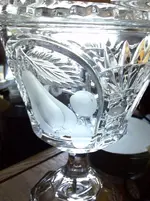

 Dylan
Dylan
